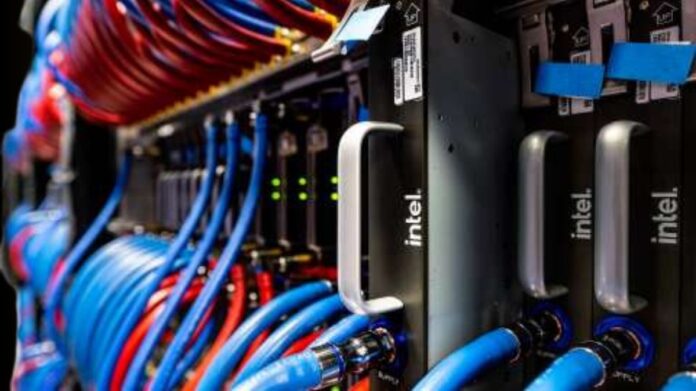Intel Aurora Supercomputer
Together with Argonne National Laboratory and Hewlett Packard Enterprise (HPE), Intel announced at ISC High Performance 2024 that the Aurora supercomputer has broken the exascale barrier at 1.012 exaflops and is now the fastest AI system in the world for AI for open science, achieving 10.6 AI exaflops. Additionally, Intel will discuss how open ecosystems are essential to the advancement of AI-accelerated high performance computing (HPC).
Why This Is Important:
From the beginning, Aurora was intended to be an AI-centric system that would enable scientists to use generative AI models to hasten scientific discoveries. Early AI-driven research at Argonne has advanced significantly. Among the many achievements are the mapping of the 80 billion neurons in the human brain, the improvement of high-energy particle physics by deep learning, and the acceleration of drug discovery and design using machine learning.
Analysis
The Aurora supercomputer has 166 racks, 10,624 compute blades, 21,248 Intel Xeon CPU Max Series processors, and 63,744 Intel Data Centre GPU Max Series units, making it one of the world’s largest GPU clusters. 84,992 HPE slingshot fabric endpoints make up Aurora’s largest open, Ethernet-based supercomputing connection on a single system.
The Aurora supercomputer crossed the exascale barrier at 1.012 exaflops using 9,234 nodes, or just 87% of the system, yet it came in second on the high-performance LINPACK (HPL) benchmark. Aurora supercomputer placed third on the HPCG benchmark at 5,612 TF/s with 39% of the machine. The goal of this benchmark is to evaluate more realistic situations that offer insights into memory access and communication patterns two crucial components of real-world HPC systems. It provides a full perspective of a system’s capabilities, complementing benchmarks such as LINPACK.
How AI is Optimized
The Intel Data Centre GPU Max Series is the brains behind the Aurora supercomputer. The core of the Max Series is the Intel X GPU architecture, which includes specialised hardware including matrix and vector computing blocks that are ideal for AI and HPC applications. Because of the unmatched computational performance provided by the Intel X architecture, the Aurora supercomputer won the high-performance LINPACK-mixed precision (HPL-MxP) benchmark, which best illustrates the significance of AI workloads in HPC.
The parallel processing power of the X architecture excels at handling the complex matrix-vector operations that are a necessary part of neural network AI computing. Deep learning models rely heavily on matrix operations, which these compute cores are essential for speeding up. In addition to the rich collection of performance libraries, optimised AI frameworks, and Intel’s suite of software tools, which includes the Intel oneAPI DPC++/C++ Compiler, the X architecture supports an open ecosystem for developers that is distinguished by adaptability and scalability across a range of devices and form factors.
Enhancing Accelerated Computing with Open Software and Capacity
He will stress the value of oneAPI, which provides a consistent programming model for a variety of architectures. OneAPI, which is based on open standards, gives developers the freedom to write code that works flawlessly across a variety of hardware platforms without requiring significant changes or vendor lock-in. In order to overcome proprietary lock-in, Arm, Google, Intel, Qualcomm, and others are working towards this objective through the Linux Foundation’s Unified Acceleration Foundation (UXL), which is creating an open environment for all accelerators and unified heterogeneous compute on open standards. The UXL Foundation is expanding its coalition by adding new members.
As this is going on, Intel Tiber Developer Cloud is growing its compute capacity by adding new, cutting-edge hardware platforms and new service features that enable developers and businesses to assess the newest Intel architecture, innovate and optimise workloads and models of artificial intelligence rapidly, and then implement AI models at scale. Large-scale Intel Gaudi 2-based and Intel Data Centre GPU Max Series-based clusters, as well as previews of Intel Xeon 6 E-core and P-core systems for certain customers, are among the new hardware offerings. Intel Kubernetes Service for multiuser accounts and cloud-native AI training and inference workloads is one of the new features.
Next Up
Intel’s objective to enhance HPC and AI is demonstrated by the new supercomputers that are being implemented with Intel Xeon CPU Max Series and Intel Data Centre GPU Max Series technologies. The Italian National Agency for New Technologies, Energy and Sustainable Economic Development (ENEA) CRESCO 8 system will help advance fusion energy; the Texas Advanced Computing Centre (TACC) is fully operational and will enable data analysis in biology to supersonic turbulence flows and atomistic simulations on a wide range of materials; and the United Kingdom Atomic Energy Authority (UKAEA) will solve memory-bound problems that underpin the design of future fusion powerplants. These systems include the Euro-Mediterranean Centre on Climate Change (CMCC) Cassandra climate change modelling system.
The outcome of the mixed-precision AI benchmark will serve as the basis for Intel’s Falcon Shores next-generation GPU for AI and HPC. Falcon Shores will make use of Intel Gaudi’s greatest features along with the next-generation Intel X architecture. A single programming interface is made possible by this integration.
In comparison to the previous generation, early performance results on the Intel Xeon 6 with P-cores and Multiplexer Combined Ranks (MCR) memory at 8800 megatransfers per second (MT/s) deliver up to 2.3x performance improvement for real-world HPC applications, such as Nucleus for European Modelling of the Ocean (NEMO). This solidifies the chip’s position as the host CPU of choice for HPC solutions.


